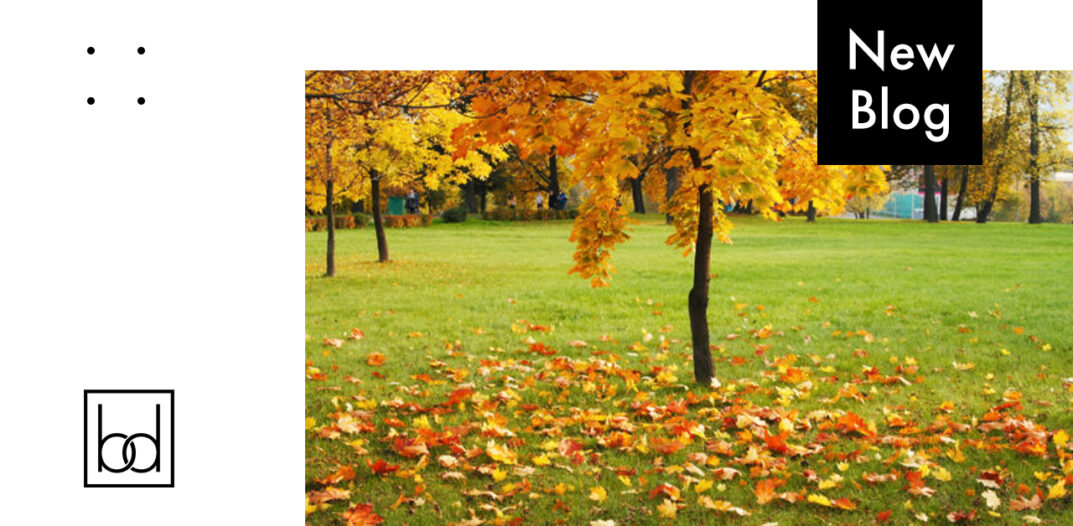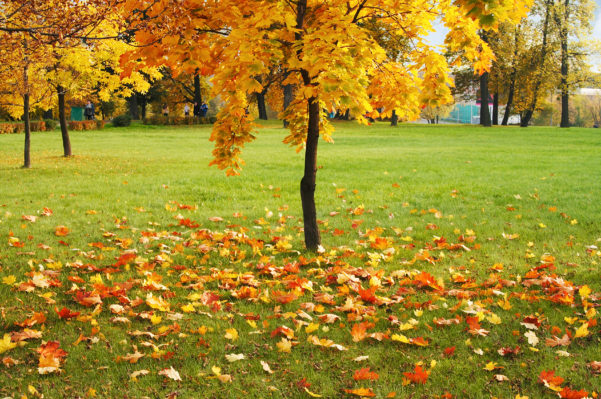
Now that the leaves are falling and your summer plants are starting to show their age, it’s time to forget about lawncare for the season, right? Not so fast! Autumn is the time for some specific tasks to be completed around the outside of your home. Ignore these tasks and you may find that your lush green lawn is lacking in luster when the warm temperatures of spring roll around again. In fact, fall is the time when the most important work for your lawn occurs – properly preparing and protecting your grass over the winter is the most important thing you can do to make sure you have a beautiful summer lawn.
Feed Your Lawn in the Fall
For your lawn to really pop in the spring, it needs the proper food in the fall. The fertilizing you do now will help your grass begin to rebuild it’s root system and repair any damage that occurred during the dry and hot stretches experienced over the summer. Bare spots from a kiddie pool or other toys can also be repaired over the fall and winter if your lawn is receiving the proper nourishment. If you are doing this job yourself, look for a product that combines fertilizer with weed killer so you can also take care of the clover and dandelion weeds that will also be repairing their root systems this season. These products are often referred to as “weed & feed” and can be found at your local home improvement store, and even in the garden section of major department stores. Fall feedings should be done in two doses, approximately 6-8 weeks apart.
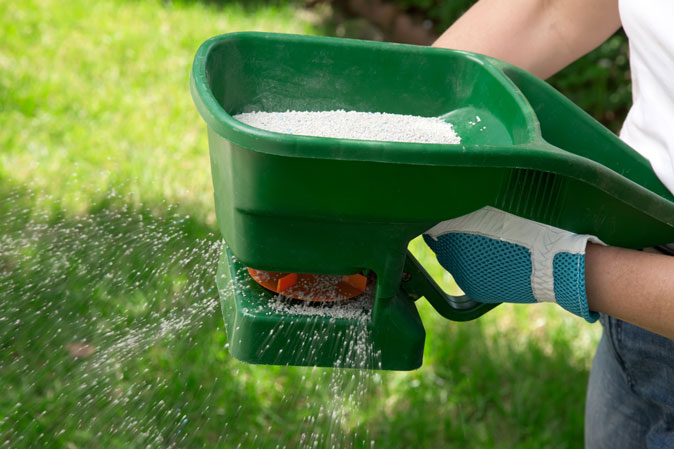
If your lawn is thin and you want to really beef up your grass for next spring, overseed the sparse areas as a part of your weed and feed routine. Visit your local garden center and specifically ask for a cool-season grass seed variety. The seeds germinate quickly in the fall and will help you fix the problem areas of your lawn. These types of grasses will also keep your lawn from suffering as much from the winter “brown out” that can occur, where your lush green lawn is replaced by a dull brown shade. Winter grasses will stay green throughout the cold season.
But, don’t continue fertilizing once the first frost hits. When your grass enters it’s dormant season of slowed growth, additional fertilizer can interfere with it’s natural progression into full dormancy. This can leave your lawn vulnerable to cold weather damage over the winter.
Now is the Time to Lay Sod Where Needed
Do you have a location in your yard where grass has not previously grown, and you’d like to expand your lawn’s coverage? Fall is the ideal time to lay new patches of sod, or repair dead spots on your lawn with sod. Mild temperatures and plentiful moisture are the best conditions for sod to get off to a good start. If the fall weather proves to be a bit dryer than expected, be sure to add significant additional hydration to make sure the new sod gets off to a good start. You’ll likely need to water the sod daily at least for the first several weeks.
Give Your Lawn Plenty of Water Throughout Winter
Many people assume that they do not need to continue watering their lawn once the weather gets cooler. While it is true that there is often more precipitation and less evaporation when the temperatures drop, you still need to be mindful of exactly how much rain your lawn is receiving. If we experience a particularly dry fall or winter, additional watering will be necessary to keep your grass healthy. Your lawn needs at least one inch of water each week, so use a rain gauge to make sure that your grass is receiving the hydration that it needs. If not, supplement by leaving your sprinklers or irrigation system running until the first frost. At that point, you’ll want to disconnect hoses and flush your irrigation system to avoid frozen pipes and spigots.
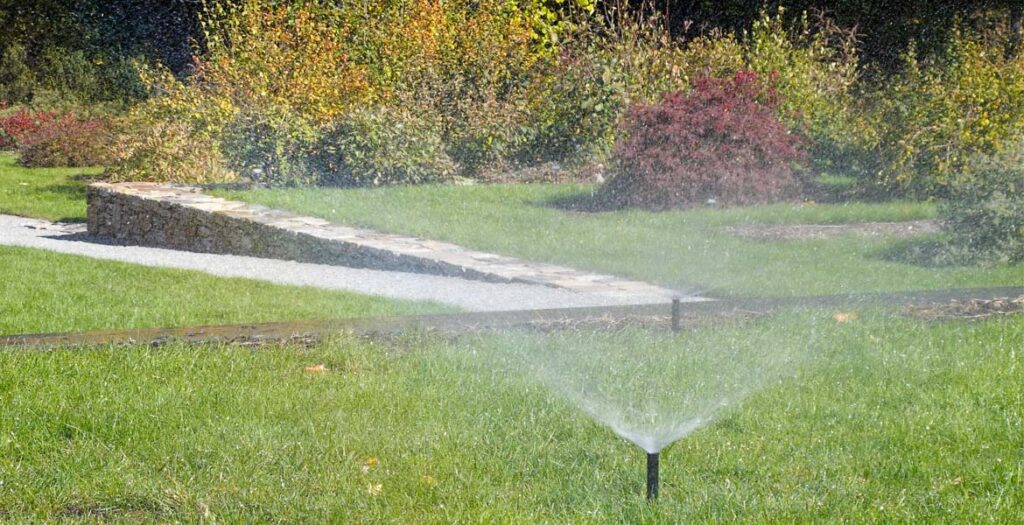
Your lawn still needs about 1 inch of precipitation every 2 weeks during the grass’s dormant season. If the winter ahead proves to be dryer than expected, consider temporarily bringing your hose back out on the occasional sunny day to give your yard a hydration boost. This should ideally be done in the morning when winds tend to be lighter, limiting evaporation. Also keep in mind what the summer was like, and how well you stayed on top of watering. If your lawn is already experiencing a drought, it will be less likely to withstand a dry winter, and will need a little bit of extra watering to stay healthy throughout the cold season.
The Best Approach for Fall Leaves
Should you let the leaves that fall on your lawn break down on their own as fertilizer, or should you rake them up immediately? While some people believe that a blanket of fallen leaves will insulate their lawn from winter’s extreme temperatures and weather, you’ll likely see more damage than benefit from leaving the leaves alone. And while some people enjoy a colorful display of fallen leaves across their lawn, others don’t think it makes for a very attractive autumn look. A thick covering of leaves over your grass blocks light and traps moisture, leading to decay.

For removing the leaves, we recommend skipping the rake and mulching instead. The best way of handling your leafy situation is to use your lawnmower to mulch the leaves into small pieces that can feed your lawn without smothering it. Do this every few days to stay on top of leaf build-up. If you have a lot of trees, you may still need to rake some of them, especially in corners where wind pushes them, but after the kids have a turn jumping in the piles, make sure some of the leaves are mulched and spread.
Keep Your Soil Loose
While you will not need do this every year, regular aeration is important for your lawn, as it prevents the soil from becoming to compacted and covered with thatch. Thatch is a layer of organic matter that can build up to as much a half inch in thickness over the top of your soil. Why does this matter? Compacted and thatch covered soil contains a thick layer of roots, stems and debris that blocks water, oxygen and nutrients from reaching your lawn’s root system. A core aerator should be used every 2-3 years to fix this issue. An aerator works by punching holes through the thatch layer of your lawn and pulling up plugs of soil. Aeration should be done just before fertilization, because it will allow the fertilizer to get deeper into the soil where it can do the most good.
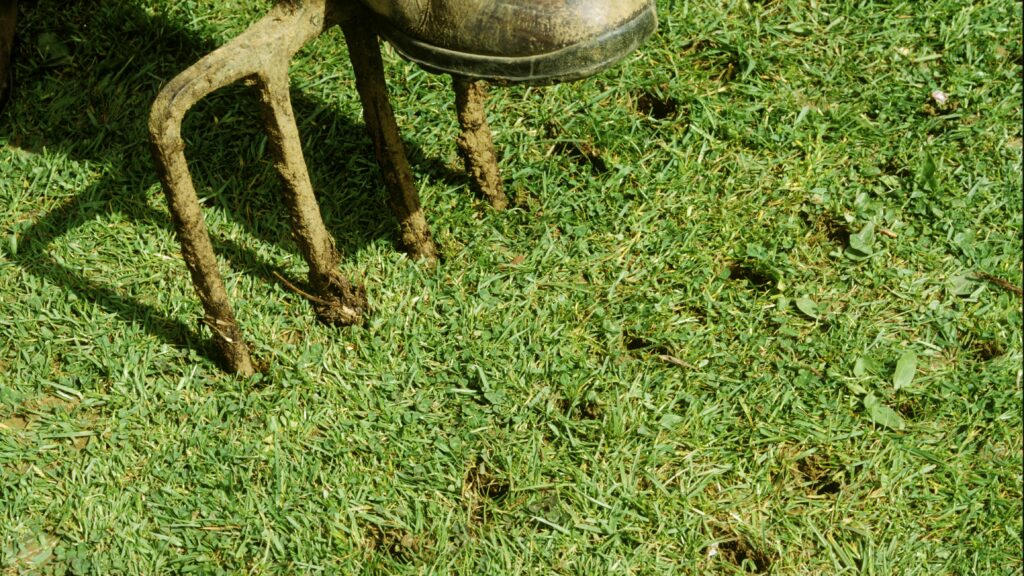
The equipment you will need to conduct a proper de-thatching and aeration is not something you will use every year, so you’ll be happy to know that it can be rented rather than purchased. You also may choose to have this work done by a lawncare professional. If not, your local home and garden store likely rents everything you need.
Don’t Forget About Lawn Pest Control
Insects can cause damage to your lawn year-round, but during the winter your grass’s fragile root system is at increased risk from pests. White grubs love to feed on thatch, so proper dethatching and aeration will help with getting rid of them. Fall armyworms are another cold weather pest that can wreck your grass. Luckily there are several commercial products available in your local home and garden store that can help you get rid of these pests. These products can be applied in conjunction with fall fertilizers and weed killers.
Keep Grass Shorter Throughout the Winter
When late fall arrives, you should begin keeping your grass shorter than you keep it during the summer. Drop your lawn mower blade down by 1 to 2 inches, and continue cutting your grass shorter until your grass stops growing completely, which usually occurs in early winter. Most varieties of grass that you find in the south will continue growing until the first hard frost of the year. When you see that your grass is going into hibernation mode, drop the blade even lower for that final cut.
Why should you keep your grass shorter throughout the winter? When grass is left too long over the winter during its no-growth phase, it is susceptible to matting and fungi growth. We may not see a lot of snow in the south, but your lawn can still grow a fungus called snow mold if it is left too long throughout the winter.

Is it possible to go too short? Yes, actually. Root depth is proportional to grass height, so cutting too short too soon can stunt the growth of roots that need to heal over the winter. This can impede your lawn’s ability to withstand winter weather, so make sure you go low, but not too low, with your mower blades. Mowing your grass too short will also draw attention to the weeds that begin springing up around your grass blades.
Don’t Forget Proper Lawn Mower Maintenance
Your grass isn’t the only thing that needs to be in great shape for the coming spring. After you have finished with the final cut later this fall, make sure your lawn mower is winterized and ready for it’s own hibernation. Sharpen your blades, clean the air filter, change the oil and sparkplugs, and inspect the mower for any damage that may have occurred. If you winterize your equipment appropriately, everything will be in perfect working order when it comes time to call your mower back into service this coming spring.

